Grus constellation is located in the southern sky. Its name originated in Latin, meaning “the Crane.” It is a relatively new constellation as it was not among the 48 Greek constellations of Claudius Ptolemy. With that said, no mythological stories are associated with it. The closest mention it has in mythology is that the crane was said to be sacred to the messenger god, Hermes.
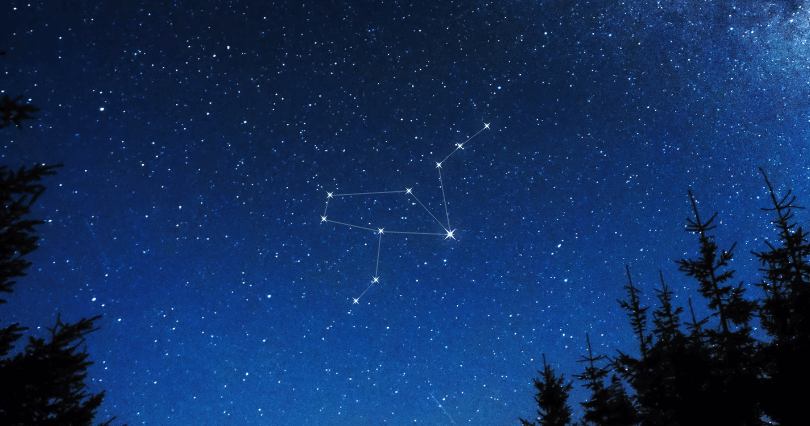
Origins Of Grus Constellation
Grus was added by Petrus Plancius based on the observations of Dutch navigators Frederick de Houtman and Pieter Dirkszoon Keyser. It is one of the constellations listed by the Dutch explorers in a period that became known as the Age of Discovery. While some Dutch constellations became obsolete, Grus remains one of the 88 modern constellations that we have today. It is abbreviated as Gru and the genitive used to refer to it is Gruis.
The boundaries of the celestial crane are defined by a polygon with 6 segments. This official border was set in 1930 by Eugène Delporte. It is the 45th largest constellation that we have. It covers an area of 366 square degrees or about 0.887% of our sky.
Bright stars in this constellation include the 1.7-magnitude, Alpha Gruis. After this blue-white star is Beta Gruis, whose apparent magnitude is around 2.1. Third in the rank is the 3.0-magnitude Gamma Gruis. These three are the only stars in the constellation brighter than the third magnitude.
No meteor showers originate from the constellation of the crane. Its deep-sky objects include the Spare-tyre nebula, NGC 7213, NGC 7424, and IC 1459 among others. The interacting galaxies of NGC 7552, NGC 7582, NGC 7599, and NGC 7590, collectively known as “The Grus Quartet” are also a great feature of this constellation. Aside from stars and deep-sky objects, Grus has planetary systems. They are hosted by six of its stars.
Grus the Crane is part of the Bayer family of constellations. Other members of this family are:
- Apus (the Bird of Paradise)
- Chamaeleon (the Chameleon)
- Dorado (the Swordfish)
- Hydrus (the Male Water Snake)
- Indus (the Indian)
- Musca (the Fly)
- Pavo (the Peacock)
- Phoenix (the Phoenix)
- Tucana (the Toucan)
- Volans (the Flying Fish)
Musca was previously called Apis (the Bee) by Bayer. As time went by, its name changed and became what we call it now.
What’s In A Name?
The crane of our night sky was known by many names before it became Grus. Earlier in the 17th century, it was called Phoenicopterus, meaning “flamingo” in Latin. This name was used in works such as Cosmographiae Generalis and a globe by Pieter van den Keere. One of the celestial navigators that observed this constellation, Frederick de Houtman, gave it the Dutch name Den Reygher (the Heron) in his star catalogue.
It was called Flamingo by many observers, noting its appearance in the sky. It was portrayed as a bird with its wings spread and its bill directed towards Pisces Austrinus, the Southern Fish. Another name for it was Bittour, old English for the marsh bird bittern.

Quick Check: How Grus Came to Be
Grus was once part of another southern constellation, Piscis Austrinus (the Southern Fish). The stars that make up the celestial crane were the ones that formed the tail of the fish constellation. Petrus Plancius separated those stars in 1597 and hence Grus was made. It appeared in different mediums after that, and its stars were given proper designations.
In 1598, it was first seen in a celestial globe published by Plancius himself and Flemish cartographer Jodocus Hondius. Later on, in 1603, it was included in Johann Bayer’s Uranometria.
Around the 1750s, French astronomer Nicolas-Louis de Lacaille did his intensive study of the southern sky. He assigned Greek letters, or the Bayer designation, to the stars of the Grus constellation in 1756.
The celestial crane is not the only constellation credited to Dutch explorers Plancius, De Houtman, and Keyser. Their work of systematically mapping the southern sky around 1595 to 1599 led to the creation of 12 new constellations.
These constellations are located far in the southern sky so the ancient Greeks and Romans were not able to chart them. When Petrus Plancius introduced them, their names were inspired differently from the classical ones. They became the sky versions of the exotic animals the explorers encountered during their travels.
Eleven of the Dutch constellations became members of the Bayer family of constellations. The 12th, Triangulum Australe, was included by Menzel in the Hercules family.
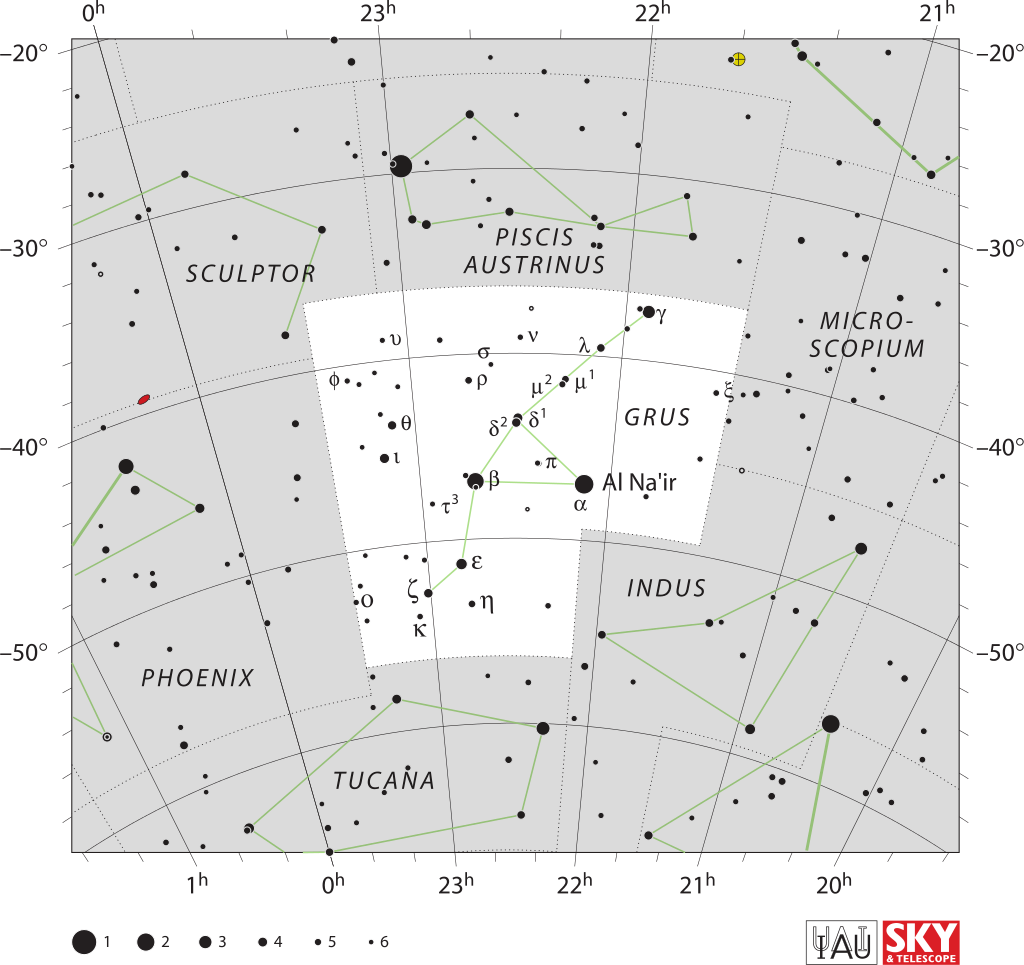
What Does Grus Look Like?
A pattern we can form from the Grus constellation is that of a bird whose wings are spread. We can most commonly make out the bird’s body, leg, and one of its wings. This wing is marked by its brightest star, Alnair (Alpha Gruis). Drawing an imaginary line to Theta Gruis, we can form its other wing. The celestial crane’s eye is marked by Gamma Gruis.
Other versions of the constellation outline its body and wings more prominently. Its neck and leg (or legs) are also more clearly depicted.
Where To See the Grus Constellation
We already know that Grus is in the southern sky. It lies in quadrant four (SQ4) of the celestial hemisphere at 22 hours right ascension and -45° declination. It is visible here on Earth at locations between latitudes +34° and -90°
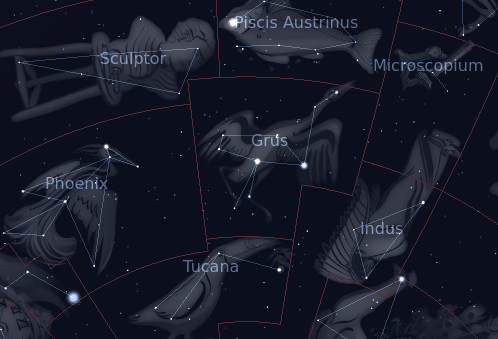
Grus and Its Neighbors
Grus is surrounded by six southern constellations. These are Piscis Austrinus (the Southern Fish), Sculptor (the Sculptor), Phoenix (the Phoenix), Tucana (the Toucan), Indus (the Indian), and Microscopium (the Microscope).
The Grus constellation together with Tucana, Pavo, and Phoenix are altogether dubbed as “the Southern Birds.”
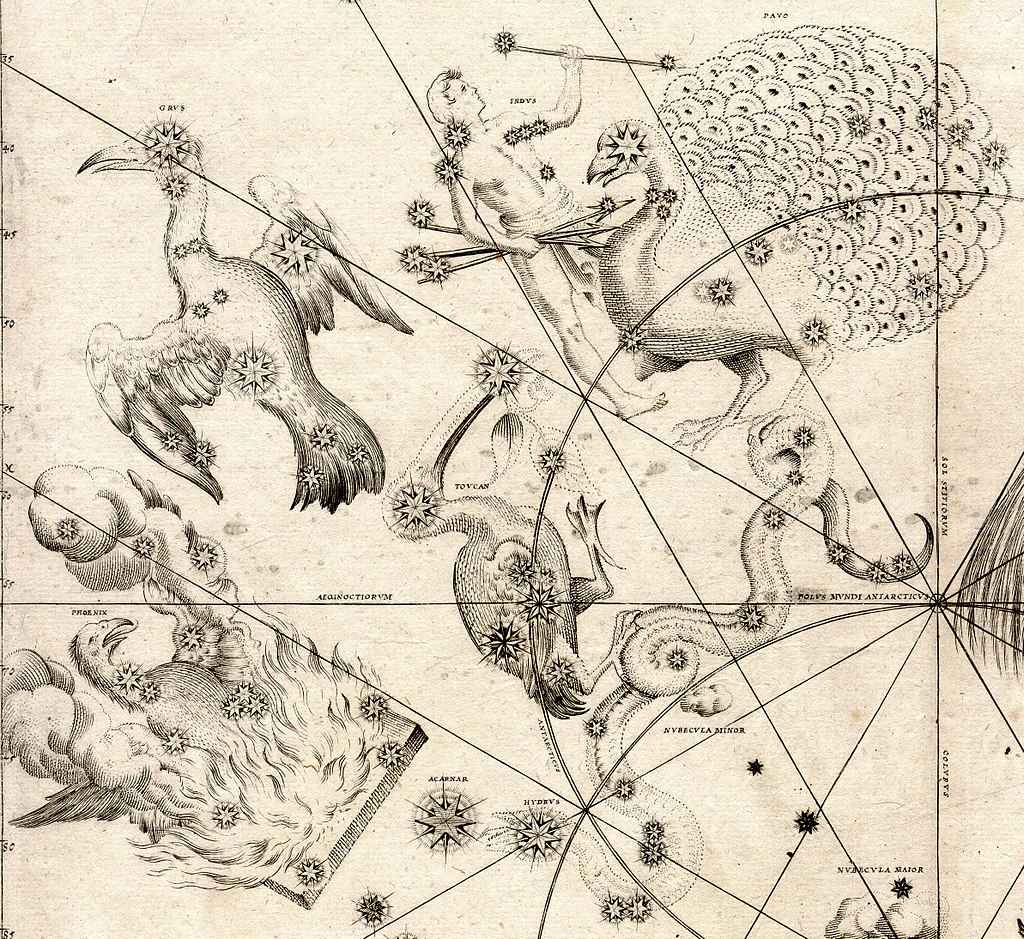
When To See the Grus Constellation
Grus is a seasonal constellation. It can be seen during the Autumn months in the northern hemisphere and Springtime in the southern hemisphere. That is around the months of September to December. We can see it best in October, at about 9 pm.
Grus and Its Stars
When the Grus constellation was made, twelve stars were included in it. Nicolas-Louis de Lacaille added some stars and gave them Bayer designations from Alpha to Phi. Later on, Benjamin Gould made some changes and added some stars designated in the Greek letters previously omitted by Lacaille. Now, some of its stars share the same Bayer designation.
Grus has eight main stars but only three of them are within the 3rd-magnitude range. The stars that are now designated Alpha, Beta, Delta, Theta, Iota, and Lambda Gruis, previously formed part of Piscis Austrinus in ancient Arabic astronomy.
The International Astronomical Union (IAU) has recognized formal names given to four stars in this constellation. These stars are Alnair, Tiaki, Aldhanab, and Itonda. The names were approved through the standardization efforts of the IAU-established Working Group on Star Names (WGSN).
Interestingly, Grus has a brown dwarf called WISE 2220−3628. It is among the coolest substellar objects ever discovered.
Alnair (α Gruis)
Alnair, or Alpha Gruis in the Bayer designation, is the brightest point in the constellation of the celestial crane. It is the 32nd brightest star in our sky, with the Sun as the brightest.
It is a B-type star whose apparent magnitude is 1.7. Alnair belongs in the stellar class B6 V, meaning that it is a main-sequence star. Other sources suggest that it is a subgiant in the stellar classification of B7 IV.
Its mass is roughly four times that of the Sun’s and is more luminous by about 520 times. This fast-rotating star has a radius of 3.4 times the solar radius. It is estimated to be 100 million years old. It lies 101 light-years distant from us.
Alnair is the traditional name of this star. Some other variations of this name are Al Na’ir and Al Nair. Its origin can be traced back to when it was a part of Piscis Austrinus. By that time, it was termed as “the bright one from the tail of the Southern Fish.” The Arabic word al-nayyir, meaning “the bright one,” remained as it became a part of Grus. It is the star that marks the left wing of the celestial crane.
Tiaki (β Gruis)
Tiaki is a red giant with the stellar classification of M5 III. It is a semiregular variable so its apparent magnitude varies between 2.0 to 2.3, changing by approximately 0.4. It is the second-brightest star in Grus.
Tiaki is 2.4 times as massive as the Sun. Its radius is also greater at 180 times solar and more luminous by 2,500 times. However, since it is an M-type star, it has a lower surface temperature than the Sun. It is about 177 light-years away.
Beta Gruis was traditionally known as Tiaki. This name was officially designated to this star in 2017 as approved by the IAU. It was the rear star in the Southern Fish’s tail before it became a part of Grus.
Aldhanab (γ Gruis)
Aldhanab is Gamma Gruis in the Bayer designation. It is a B-type star with an apparent magnitude of 3.003, so we can see it in the naked eye. It is the third brightest star in the southern constellation of Grus.
Gamma Gruis is a giant star that is in the spectral class B8 III. It is 3.06 as massive as our Sun, with a radius 4.5 times the solar radius. It radiates with the luminosity of roughly 390 Suns. This blue-white hued star is 211 light-years from our Sun.
Al Dhanab was the traditional name of this star. It means “the tail” in Arabic, referring to its previous position in the constellation of Piscis Austrinus. Now, it is the star marking the eye of Grus.
Delta1 Gruis (δ1 Gruis)
Delta1 Gruis is believed to be a binary star that is about 309 light-years distant. It is a giant star that is approximately three times as massive as our Sun. Its apparent magnitude varies between 3.99 and 4.2 because it is a semiregular variable. This star is in the stellar class G6/8 III. It has a much fainter companion, having an apparent magnitude of 12.8.
Delta2 Gruis (δ2 Gruis)
Delta2 Gruis is an M-type solitary star. Its stellar classification is M4.5 IIIa. The apparent magnitude of this star is about 4.11 so it is visible to us in the naked eye. There are some variations around that magnitude when this pulsating variable undergoes multiple periods.
The distance of Delta2 Gruis from the Sun is estimated to be 330 light-years. It has a visual companion, 9.71 in magnitude. This red giant shares the Delta designation with the yellow star Delta1 Gruis.
Epsilon Gruis (ε Gruis)
Epsilon Gruis is an A-type star with an apparent magnitude of 3.5. Its stellar classification is A2IVn. This blue-white hued star has an oblate shape as a result of its rapid rotation. It is 1.85 as massive as the Sun. Epsilon Gruis is believed to be 249 million years old, located roughly 129 light-years away.
Zeta Gruis (ζ Gruis)
Zeta Gruis is a K-type star with an apparent magnitude of 4.12. Its stellar classification is K1 III Fe−1.2 CN−0.5. Some sources say that it is a yellow giant in the G8III stellar class. It is about 46 times as luminous as the Sun, located about 133 light-years distant.
Eta Gruis (η Gruis)
Eta Gruis is a K-type star with an apparent magnitude of 4.85. It is a microvariable, a variable star that undergoes very slight variations. This CN star has a stellar classification of K2 III CNIV. Its radius is about 31 times solar, having a luminosity of 338.5 times that of the Sun’s. It is 460 light-years distant from us.
Theta Gruis (θ Gruis)
Theta Gruis is a multiple star system of at least three stars. Its overall apparent magnitude is 4.28, see we can see in the unaided eye. Theta Gruis marks the right wing of Grus. It is roughly 132 light-years away.
Iota Gruis (ι Gruis)
Iota Gruis is a spectroscopic binary with an apparent magnitude of 3.90. The primary star has a stellar classification of K1 III. The orbital period of this binary is 409.6 days. It is located 183 light-years from Earth.
Kappa Gruis (κ Gruis)
Kappa Gruis is a K-type star of 5.37 apparent magnitude. Its radius is about 29.6 times that of the Sun’s and it is radiating at 200 solar luminosities. The stellar classification of this giant star is K5 III. It is 368 light-years away.
Lambda Gruis (λ Gruis)
Lambda Gruis is an orange star with the stellar classification K3 III. It has an apparent magnitude of 4.47. This K-type giant is 2.4 times as massive as the Sun and is 155 times as luminous. It is 242 light-years from Earth.
Mu1 Gruis (μ1 Gruis)
Mu1 Gruis is a binary star of 4.79 combined apparent magnitude. Its components have an orbital period of 19 years. The primary belongs in the stellar class G III. This yellow star has a radius 9.3 times that of the Sun’s. It radiates with the luminosity of 67 Suns. The other component is also a G-type star. Mu1 Gruis is 275 light-years away from our planet.
Mu2 Gruis (μ2 Gruis)
Mu2 Gruis is a G-type star that is suspected to be a binary. Its apparent magnitude is 5.10. Being a variable star, its amplitude is about 0.004 magnitude. The primary belongs in the stellar class G8 III. It is 56 times as luminous as the Sun. Mu2 Gruis is 248 light-years away from Earth.
Pi1 Gruis (π1 Gruis )
Pi1 Gruis is a cool giant or an S-type star. It was among the first known stars of this kind. The unusual spectrum of this star was first noticed by American astronomer Annie Jump Cannon. It is already aging and will soon form a planetary nebula. This S5 spectral type star is 530 light-years from us. It has a yellow companion which has a stellar classification of G0V
Pi1 Gruis shares the same Bayer designation with Pi2 Gruis, an unrelated binary star that is an optical double. Remember that an optical double only appears close with each other from our line of sight here on Earth.
RZ Gruis
RZ Gruis is a binary composed of a main-sequence star and a white dwarf. They have an orbital period of 8.5 to 10 hours. It is a cataclysmic variable that is in the subgroup of UX Ursae Majoris. The main-sequence star is thought to be in the spectral class F5V.
RZ Gruis has an apparent magnitude of 12.3 which dims up to 13.4. The spectra of its components are comparable to that of a nova. There is still much to be known in this star system. It is estimated to be 1,434 light-years away from us.
Gliese 832
Gliese 832 is also called GJ 832. We cannot see it in the naked eye as its apparent magnitude is 8.66. It has the stellar classification M2V. This red dwarf is less massive than the Sun by nearly 50% and its radius is 0.48 times solar. Two extrasolar planets were discovered around it, Gliese 832 b and c. The planetary system is located about 16.2 light-years from our Sun.
Itonda (HD 208487)
HD 208487 is a G-type star that was formally given the name Itonda. It is in the spectral class G2V. This yellow-hued star is 7.47 in magnitude. An exoplanet, given the designation HD 208487 b, was discovered orbiting it. This planetary system is about 147 light-years distant.
WASP-95
WASP-95 is another star in the Grus constellation that hosts an exoplanet. It belongs in the G2 spectral class and is 10.1 in apparent magnitude. It is 1.11 times as massive as the Sun, with a radius of 1.13 times the solar radius. This sunlike star is located about 460 light-years from us.
HD 213240
HD 213240 is a binary star that is made up of a yellow star and a red dwarf. It has an apparent magnitude of 6.81. The G-type star has the stellar classification of G4IV. This star has about 1.57 times the mass of the Sun. It is radiating 2.69 times as much as our Sun’s luminosity. HD 213240 is 133.5 light-years distant. The exoplanet that orbits it is called HD 213240 b.
HD 215456
HD 215456 is a main-sequence star that is 6.63 in apparent magnitude. It is in the spectral class G0.5V, at a distance of 129 light-years. It has a mass of 1.2 times the solar mass. This main sequence star hosts a planetary system with two exoplanets.
Tau1 Gruis (HD 216435)
Tau1 Gruis is a G-type star of G0 V spectral type. It is1.28 times as massive as the Sun. It radiates at a luminosity that is about 3 times that of the Sun’s. Its apparent magnitude is 6.02. This star with a yellow hue is 106 light-years away from us here on Earth. It has an exoplanet companion, designated HD 216435 b.
Planets in the Crane’s Constellation
Six of the stars in the Grus constellation host planets with some having at least two members. One of them, Gliese 832, hosts a planetary system that is one of the closest to us, at 16.2 light-years away.
Gliese 832 b
Gliese 832 b, also designated GJ 832 b, is a gas giant orbiting the red star Gliese 832. It is 0.68 times as massive as the largest planet in our solar system. This Jupiter-like exoplanet orbits the star in a period of about 10 years, at a distance of 3.56 AU.
Gliese 832 b has the longest period among Jupiter-like planets that orbit a red dwarf. It was discovered in 2008.
Gliese 832 c
Gliese 832 c is the second planet discovered in the planetary system of the M-type star Gliese 832. It is in the habitable zone, having a mass of 5.4 Earths. This Neptune-like gas giant has an orbital period of 35.7 days. Just like with Gliese 832 b, it was detected using the radial velocity technique. It was discovered in 2014.
HD 208487 b
HD 208487 b is a Jupiter-like exoplanet. This gas giant is also called Itonda b, after the official name given to its star. It has a mass of 0.52 of Jupiters and an orbital period of 130.1 days. The IAU has approved the name Mintome to this exoplanet.
WASP-95 b
WASP-95 b is a hot Jupiter, an exoplanet that is said to have a size comparable to Jupiter but whose orbital period is notably short. It is 1.44 times as massive as Jupiter but only takes 2.2 days to orbit the star of its planetary system. It was discovered through the Transit method in 2013.
HD 213240 b
HD 213240 b is an exoplanet that is primarily composed of gas. It is also designated HD 213240 Ab as it orbits the G-type A component in the HD 213240 binary system. This gas giant has a mass of 5.58 Jupiters and an orbital period of 2.4 years. It was discovered in 2001 through the Radial Velocity method.
HD 215456 b
HD 215456 b is an exoplanet that orbits the G-type star HD 215456. It has a mass of 0.10 Jupiters or 32.1 Earths. Its orbital period is 192 days, orbiting its star at a distance of 0.65 AU. It was detected in 2011 via Radial Velocity.
HD 215456 c
HD 215456 c is another exoplanet in the planetary system of the yellow star HD 215456. Its mass is 0.246 Jupiters or 78.2 Earths. It has a longer period of 2, 277 days. It was detected in 2011 and was confirmed in 2020 together with HD 215456 b.
HD 216435 b (Tau1 Gruis)
HD 216435 b is a gas giant that is 1.26 times as massive as Jupiter. At a distance of 2.56 AU from its G-type star, it completes an orbit in a period of 3.6 years. It is in the habitable zone. This exoplanet was discovered in 2002.
Deep-sky Objects in Grus Constellation
Grus has no Messier objects. However, it has some galaxy groups consisting of spiral, elliptical, and barred spiral galaxies. The nebula IC 5148, which looks like a cosmic spare tyre (tire), is in this constellation.
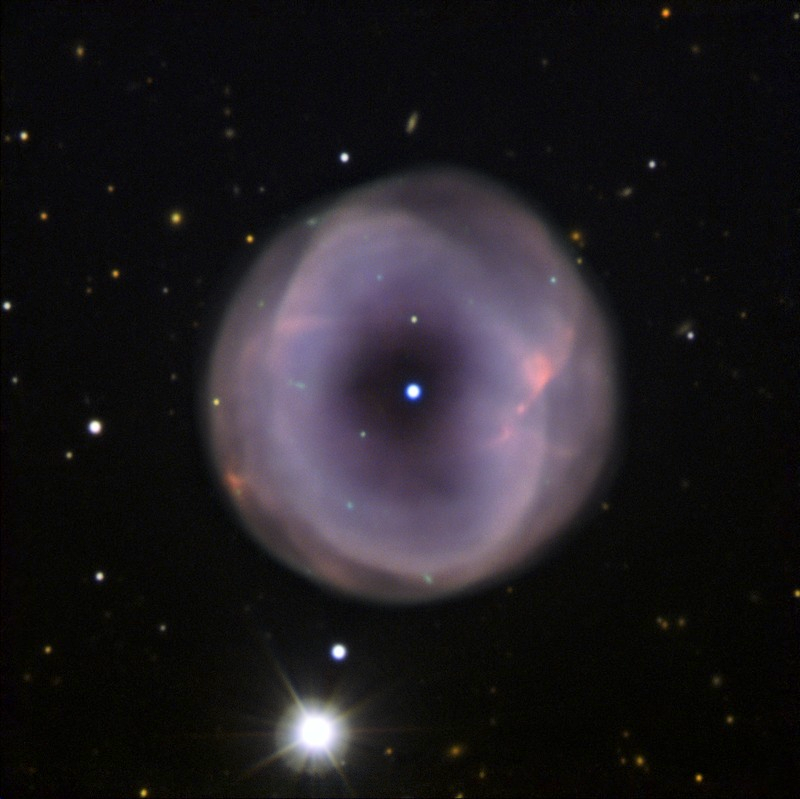
Spare Tyre Nebula
The Spare Tyre nebula is another name given to the planetary nebula IC 5148. It is located near the star Lambda Gruis, or close to the “neck” of the celestial crane in the constellation outline. It was discovered in 1894 by Walter Gale. This planetary nebula appears as a ring of material surrounding a white dwarf in the center, with a vacant space in between. This planetary nebula is fast expanding, at a rate of about 50 kilometers per second. It is 3,00 light-years away from us.
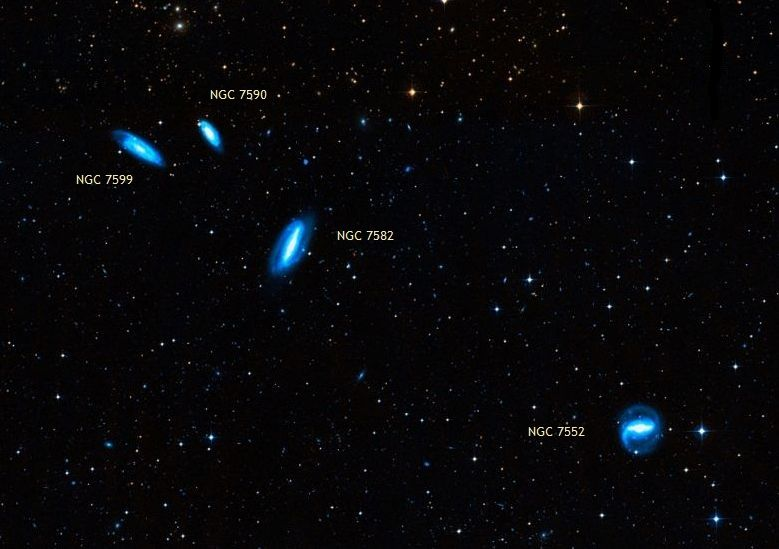
The Grus Quartet
The Grus Quartet is made up of four galaxies in Grus: NGC 7590, NGC 7599, NGC 7582, and NGC 7552. These interacting spiral galaxies are located near Theta Gruis. They are at about 60 million light-years distant.
NGC 7590 and NGC 7599 are the most tightly wound galaxies among the four. NGC 7582 is located at the center of the Grus Quartet and is the one most studied. Its apparent magnitude is 11.37 and is 100,000 light-years in diameter. This type 2 Seyfert galaxy has a supermassive black hole in its center.
NGC 7552 is a barred spiral galaxy that is estimated to be 75,000 light-years across. It has two spiral arms, with one brighter than the other. The more prominent arm is populated by younger stars. Star clusters are also detected in this region.
Out of the quartet, the galaxies NGC 7590, NGC 7599, and NGC 7582 are also known as the Grus Triplet. The smallest of them is NGC 7590.
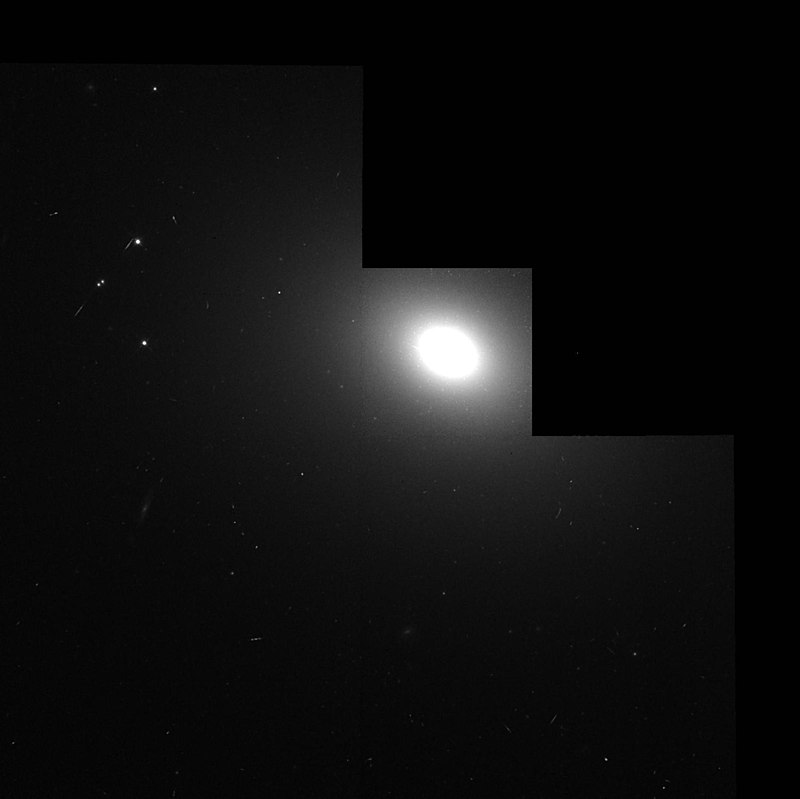
IC 1459
IC 1459 is a giant elliptical galaxy that is 85 million light-years away from our planet. It is also designated IC 5265. It is roughly 130,000 light-years across and has an active nucleus. This is the brightest member of the IC 1459 group of galaxies. Other galaxies in the group are NGC 7418, NGC 7418A, IC 5264, and IC 5270 among others. American astronomer Edward Emerson Barnard discovered IC 1459 in 1892.
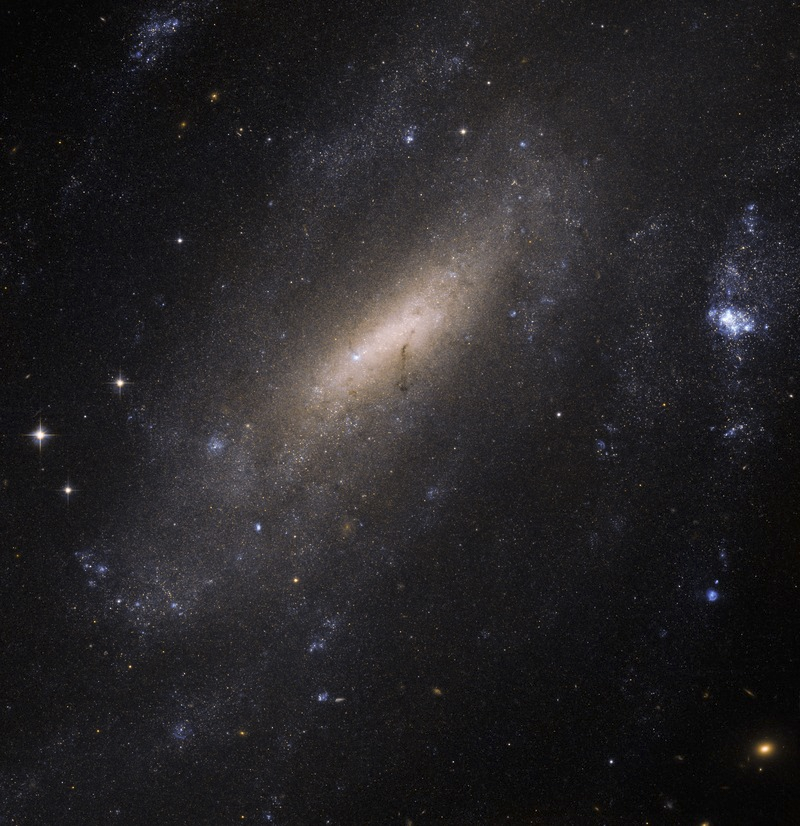
IC 5201
IC 5201 is a spiral galaxy with a bright central bar. New stars are born in the thin arms of this isolated galaxy. Such activities were also detected in the said galaxy’s nucleus. It is approximately 90,000 light-years in diameter and is located about 36 light-years distant from our planet. A type II supernova has been discovered in this galaxy.
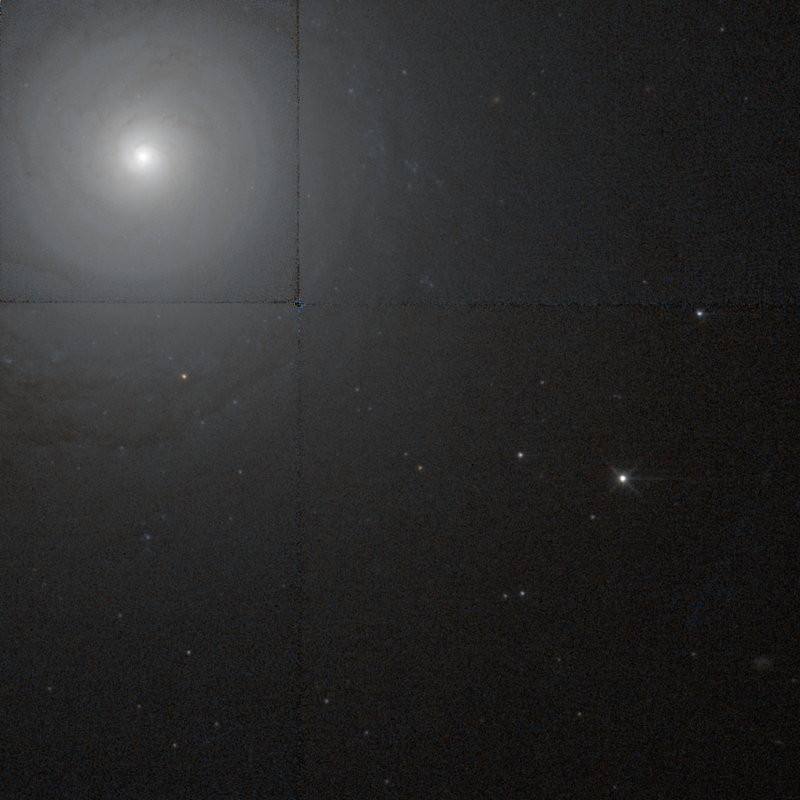
NGC 7213
NGC 7213 is an active galaxy that is approximately 75,000 light-years across. With an apparent magnitude of 10.1, it is among the brightest of its kind in the constellation of Grus. It is estimated to be 70 million light-years distant. English astronomer John Herschel discovered it in 1834.
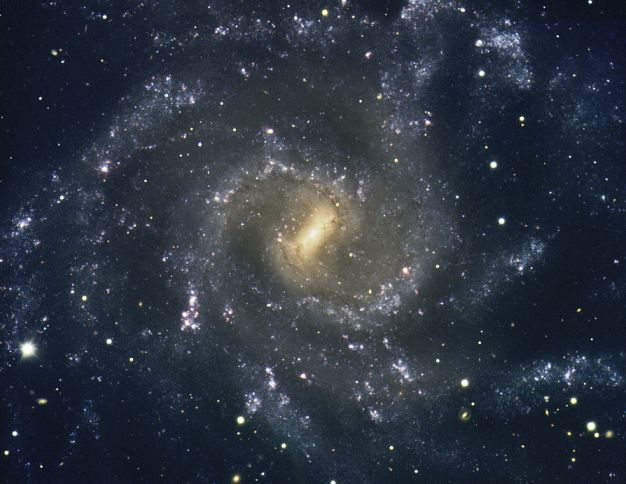
NGC 7424
NGC 7424 is a spiral galaxy with a notable central bar. Its winding arms are home to many star clusters revealed by the presence of blue and massive young stars. It measures 100,000 light-years in diameter, which is somewhat comparable to that of the Milky Way. The supernova SN 2001ig originated from this galaxy.